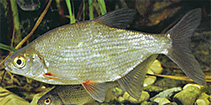Lithuania country information
Common names:
Plakis
Occurrence: native
Salinity: freshwater
Abundance: common (usually seen) | Ref: Winkler, H.M., K. Skora, R. Repecka, M. Ploks, A. Neelov, L. Urho, A. Gushin and H. Jespersen, 2000
Importance: | Ref:
Aquaculture: | Ref:
Regulations: | Ref:
Uses: no uses
Comments:
National Checklist:
Country Information: https://www.cia.gov/library/publications/resources/the-world-factbook/geos/lh.html
National Fisheries Authority:
Occurrences: Occurrences Point map
Main Ref: Blanc, M., J.-L. Gaudet, P. Banarescu and J.-C. Hureau, 1971
National Database:
Occurrence: native
Salinity: freshwater
Abundance: common (usually seen) | Ref: Winkler, H.M., K. Skora, R. Repecka, M. Ploks, A. Neelov, L. Urho, A. Gushin and H. Jespersen, 2000
Importance: | Ref:
Aquaculture: | Ref:
Regulations: | Ref:
Uses: no uses
Comments:
National Checklist:
Country Information: https://www.cia.gov/library/publications/resources/the-world-factbook/geos/lh.html
National Fisheries Authority:
Occurrences: Occurrences Point map
Main Ref: Blanc, M., J.-L. Gaudet, P. Banarescu and J.-C. Hureau, 1971
National Database:
Common names from other countries
分类 / Names 俗名 | 同种异名 | Catalog of Fishes(属, 种) | ITIS | CoL | WoRMS | Cloffa
Environment: milieu / climate zone / depth range / distribution range 生态学
分布 国家 | FAO区域 | 生态系 | 标本纪录 | Point map | 简介 | Faunafri
Europe and Asia: North, Baltic, White, Black (south to Rioni drainage) and Caspian Sea basins, Atlantic basin southward to Adour drainage (France; possibly introduced southward of Loire) and Mediterranean basin in France (Hérault and Rhône drainages). In Aral, Marmara and Anatolian Black Sea basins west of Ankara. Naturally absent from Iberian Peninsula, Italy, Adriatic basin, Crimea, Great Britain (except southeast), Scandinavia north of Sundsvall (Sweden) and 65° N (Finland). Locally introduced in Spain and northeastern Italy; in France, apparently introduced in smal coastal drainages of Var.
歐洲: 法國到烏拉河除義大利,希臘與前南斯拉夫。
歐洲: 法國到烏拉河除義大利,希臘與前南斯拉夫。
Length at first maturity / 大小 / 重量 / 年龄
Maturity: Lm ? range ? - ? cm
Max length : 45.5 cm TL 雄鱼/尚未辨别雌雄; (Ref. 88166); common length : 20.0 cm TL 雄鱼/尚未辨别雌雄; (Ref. 556); 最大体重: 1.0 kg (Ref. 30578)
Max length : 45.5 cm TL 雄鱼/尚未辨别雌雄; (Ref. 88166); common length : 20.0 cm TL 雄鱼/尚未辨别雌雄; (Ref. 556); 最大体重: 1.0 kg (Ref. 30578)
简单描述 检索表 | 型态特徵 | 形态测量图
背棘 (总数) : 3; 背的软条 (总数) : 8; 臀棘: 3; 臀鳍软条: 19 - 22; 脊椎骨: 39 - 40. The only species of the genus which can be diagnosed from similar species of genera Ballerus, Blicca and Vimba by having the following characters: mouth sub-inferior, which can not be extended as a tube; scales on lateral line 43-46 + 2-3 ; anal fin with 19-23½ branched rays; eye diameter about equal to snout length in individuals larger than 10 cm SL; pharyngeal teeth 2,5-2,5; and orange or reddish base of paired fins (Ref. 59043). Caudal fin with 17-19 rays (Ref. 2196).
尾鳍有 17-19个鳍条。 (参考文献 2196)
尾鳍有 17-19个鳍条。 (参考文献 2196)
Gregarious and frequents stagnant waters of lakes and reservoirs, rivers and canals with calm waters. Occurs in a wide variety of shallow, warm lowland lakes and slow-flowing lower reaches of large rivers and canals. Frequently very abundant on bottom of large sandy rivers. Larvae live in still water bodies. Mainly nocturnal. Feeds on benthic invertebrates. Spawns along shores on submerged vegetations, roots or even on shallow gravel bottom (Ref. 59043). Reproduction takes place in May to July. Exhibits polyandry (Ref. 6114). Regularly hybridizes with Vimba vimba (Ref. 59043). Of little interest to game fishers and consumers (Ref. 30578). Unpopular with commercial fishers due to its small size and competition with more desired species.
群居的而且常常聚集于湖与水库,河与管的污浊水域且水面平静的地方。 吃小型底栖的无脊椎动物,昆虫幼生与植物。 稚鱼吃浮游动物。 繁殖发生于五月到七月。 显示一妻多夫。 钓客对它少有兴趣与消费者.(参考文献 30578) 不受渔民欢迎由于它的体型小而且竞争需求鱼种。
群居的而且常常聚集于湖与水库,河与管的污浊水域且水面平静的地方。 吃小型底栖的无脊椎动物,昆虫幼生与植物。 稚鱼吃浮游动物。 繁殖发生于五月到七月。 显示一妻多夫。 钓客对它少有兴趣与消费者.(参考文献 30578) 不受渔民欢迎由于它的体型小而且竞争需求鱼种。
Life cycle and mating behavior 成熟度 | 繁殖 | 产卵场 | 卵 | 孕卵数 | 仔鱼
Exhibits polyandry, with courting tactics developed by males. Trembling and splashing movements signal release of eggs and sperms on plant substratum (Ref. 6114). Eggs are sticky (Ref. 59043).歐洲: 法國到烏拉河除義大利,希臘與前南斯拉夫。
主要参考文献
Upload your references | 参考文献 | 合作者 | 合作者
Kottelat, M. and J. Freyhof, 2007. Handbook of European freshwater fishes. Publications Kottelat, Cornol and Freyhof, Berlin. 646 pp. (Ref. 59043)
对人类的威胁
无害处的
人类利用
渔业: 低经济; 水族馆: 公众的水族馆; 诱饵: occasionally
FAO(Aquaculture systems: 产生; 渔业: 产生; publication : search) | FishSource |
更多信息
Population dynamics
成长参数
Max. ages / sizes
Length-weight rel.
Length-length rel.
体长-频率
Mass conversion
入添量
丰度
成长参数
Max. ages / sizes
Length-weight rel.
Length-length rel.
体长-频率
Mass conversion
入添量
丰度
Physiology
Body composition
Nutrients
耗氧量
游泳类型
游泳速度
Visual pigments
Fish sound
Diseases & Parasites
Toxicity (LC50s)
Body composition
Nutrients
耗氧量
游泳类型
游泳速度
Visual pigments
Fish sound
Diseases & Parasites
Toxicity (LC50s)
工具
E-book | 野外调查 | 检索表 | 长度- 频率 Wizard | 生活- 历史的工具 | 分布图 | Classification Tree
| Catch-MSY |
特别资料
下载 XML
网络资源
Alien/Invasive Species database | Aquatic Commons | BHL | Cloffa | Websites from users | 核实 FishWatcher | CISTI | Catalog of Fishes(属, 种) | DiscoverLife | ECOTOX | Faunafri | Fishtrace | GenBank(基因组, 核苷酸) | GloBI | GOBASE | | Google Books | Google Scholar | Google | IGFA World Record | MitoFish | 国家资料库 | Otolith Atlas of Taiwan Fishes | 公众的水族馆 | PubMed | Reef Life Survey | Scirus | SeaLifeBase | 树状分类阶层 | Wikipedia(转至, 搜寻) | World Records Freshwater Fishing | 动物学的记录
Estimates based on models
Phylogenetic diversity index (Ref. 82804): PD50 = 1.0000 [Uniqueness, from 0.5 = low to 2.0 = high].
Bayesian length-weight: a=0.00741 (0.00669 - 0.00822), b=3.15 (3.12 - 3.18), in cm Total Length, based on LWR estimates for this species (Ref. 93245).
营养阶层 (Ref. 69278): 3.2 ±0.0 se; based on diet studies.
回复力 (Ref. 120179): 中等的, 族群倍增时间最少 1.4 - 4.4年 (K=0.10-0.27; tm=3-4).
Fishing Vulnerability (Ref. 59153): High vulnerability (65 of 100).




